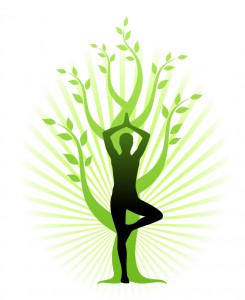
Yoga is an ancient practice, originating in India around around 500 years BCE. The original focus was on ‘taming the mind’ in order to find a path to spiritual enlightenment and the practices were often austere: restricting food or behaviours, hours of sitting meditation. Yoga was mainly practiced by men who had renounced normal life.
Yoga has undergone a transformation since then. In the West it is best known for a physical practice (‘Hatha Yoga’) and takes place in gyms, hot studios and offices on a daily basis. It remains for some as a stepping stone to a meditative practice (‘Dhyana’) but even for those who don’t come for enlightenment often find that the link between body and mind remains a close one.
These links are now well known to modern science too, and there is no end of neuroscience research on brain patterns in breathing, stress and pain (and sometimes all three!). We know that stress can increase feelings of pain coming from the body, and pain can affect our emotions and behaviours, stopping us doing the things that we love, as we may fear causing more pain to an already-injured self. Living with pain, be it recent or long-standing, or due to injury or illness, can be yet another load in an already stressful modern life.
From a physical perspective, Yoga enables us to connect to our bodies – feeling what really hurts, which bit needs length and which strength – to build a well-connected whole self. Specific practices (Pranayama) teach better breathing. These build health by allowing the cardio-vascular system to work more efficiently. Practicing yoga on a regular basis can reduce pain and help in recovery after injury, as well as unwinding the postural patterns caused by too much sitting, texting or tension.
What’s more, you don’t need to chant or meditate all day to improve your mental clarity. Just taking the time to concentrate on your body starts to build a higher level of awareness and focus, allowing you to draw your minds’ attention away from work or other worries. Again, learning to work with the breath helps to quiet an active mind and has a well-researched effect on the nervous system. Yoga students often report that they learn about themselves on the mat too – you start to notice your inner repetitive voice “I can’t do that !” or “that might hurt”. By becoming aware and changing these behaviours (if you want to !) Yoga builds mental flexibility too.
One-to-one yoga tuition gives you an extra level of knowledge in your practice. The teacher can provide specific adjustments for YOUR body (remember we are not all built the same!) and provide you with an individualised practice schedule. If you already practice yoga, one-to-ones can provide a new challenge for both body and mind and allow you to go deeper than in a group setting. Why do my feet have to be here and not there ? What if my hips don’t open in that way ? Sometimes we need to question the teacher too.
So, who can benefit from a yoga practice ? The simple answer is EVERYONE – whatever age, gender or physical condition. We have much to learn from our bodies and this is a great way to start, whether you are at peak fitness or working with a challenge. Don’t be put off by the pictures of lean young things in lycra – we all live on a physical continuum between stiff and flexible – and modern life often keeps pulling us towards rigidity.
So Yoga can do plenty for you ! Yoga classes can be found literally everywhere these days… What have you got to lose ?
Anji Gopal is a Registered Osteopath and Yoga Teacher. Her interests lie in working with individuals to find health in their daily life, whether coping with persistent pain dealing with stress or injury recovery. Her teaching is informed by anatomy, science, alignment and a curious mind, all with a sense of practical focus and fun. 1:1 lessons will involve an individual assessment of your needs and an individualised self-practice programme. Group classes are also small so you can get personal attention.
References:
Farhi, D. (1996), The Breathing Book
Feuerstein, G. (2001) The Yoga Tradition: Its History, Literature, Philosophy and Practice
Gard T et al (2014) Potential self-regulatory mechanisms of yoga for psychological health, Frontiers in Human Neuroscience
Ussher M et al (2014) Immediate effects of a brief mindfulness-based body scan on chronic pain.
